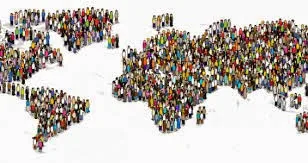Population growth is not
considered as an act of nature as it is a choice of human beings to procreate.
With that, it is safe to safe that humanity can prevent population explosion
and avoid problems associated with a large population such as lack of social
services, hunger, social chaos, and different forms of societal problems. At present, the world’s population is fast
approaching the 8 billion levels as there are nearly 140 million people added
annually with only less than 50 million death rates.
 |
| Image from audiotech.com |
Some of the interesting
yet troubling facts about Earth’s population are that more than one billion
people lack ample food and potable drinking water. More and more people are living in unsafe
areas like flood prone plains, tsunami exposed areas, crime infested cities,
and among others. The gap between the
rich and the poor becomes more obvious each time a new baby is born as such
social problems becomes more difficult to address and compounding more problems
are the environmental effects of increasing population.
The Philippine Population Situation
The Philippines has one of
the highest population growth in Asia pegged at 2.04% yearly. As of 2014 estimates, the country has now
more than 100 million Filipinos. Yes,
despite huge efforts of the government to curb population, birth rate remains
explosive, the Philippines now ranks as the 12th most populated
country in the whole world. As income opportunities in rural areas become
scarcer, Filipinos are migrating in the urban jungle and add more problems to
different cities in the country.
The Top Ten Most Populated Cities in the Philippines
It is interesting to note that the most populous cities
in the country are situated in the Greater Manila area and only three from outside
of this region.
- Quezon
City – As of last estimate, it has a population figure of more than 2.1
million people. It is part of the Metro
Manila region and is the largest city in this area. This was once the former capital city of
the country and is home to many national government offices. It also hosts several headquarters of
private companies and a huge portion of this city is considered as
residential areas.

Image from WikimediaCommons.com
- Manila
– Do not confuse this with the entire Metro Manila region, as this city
refers to the old Manila City and is home to more than 1.6 million
Filipinos. It is located near
Manila Bay on the eastern side and has Caloocan, Navotas, Quezon City, and
San Juan as border cities. It is the most densely populated area as it has
only nearly 2,500 hectares in terms of land area. It is also home to many national
government offices, educational institutions, and private companies.

Image from mahoganytours.com
- Caloocan
City is one of the most historically significant cities in the country as
this city was the center of revolutionary activities of the Katipunan; a
secret revolutionary society during the Spanish period. The
city is home to many residential villages and some few private company
headquarters and warehouses.

Image from positivelyfilipinos.com
- Davao
City is one of the premier cities in the south, Davao City has transformed
from a “no man’s land” city during the eighties to become one of them most
liveable and child friendly cities in the world. It has more than 1.4 million Filipinos
as of last estimates. It has a
total land area of 2,444 square kilometres, making it as the largest city
in the country in terms of land area.
Davao City is one of the main trading centers and hub of commerce
and industry in Mindanao.

Image from vacation4all.blogspot.com
- Cebu
City is considered as the second city in the Philippines as Cebu is
considered as the second most significant city in the country after Metro
Manila in terms of trading, commerce, and industry. This city has a population count of
886.771. The city is tagged as the
“Queen City of The South" and is home to more than 80% of shipping
companies in the entire country.
Cebu City is also home to many premier educational institutions in
the country.

Image from cebubloggers.com
- Zamboanga
City is known as the “Asia’s Latin City.” It has a population
figure of more 800,000 Filipinos and the 3rd largest city in
the Philippines in terms of land area.
It serves as the center of commercial and industrial activities in
the entire Zamboanga Peninsula Region.
It formally became a city on February 26, 1937 and became a
chartered city on October 12, 1936.

Image from itsmorefuninthephilippines.com
- Taguig
City is one of most highly urbanized city in the southern part of Metro
Manila. It was once a fishing
community and now has a population of over 644,000 Filipinos. It is home to one of the business
centers in Metro Manila; Fort Bonifacio.
It is bordered by Laguna de Bay on the western side, Muntinlupa in
the south, Pasay in the west side, and Pasig on the North.

Image from biyahengmanila.weebly.com
- Antipolo
City is roughly 25 kilometers away from Metro Manila and is
the largest city in the CALABARZON area.
With a population of more than 677,000 people, it is known as the
“Pilgrimage Capital of the Philippines” as thousands of Filipinos troop to
this city each year to pay respect to the Virgin of Antipolo. It became a
component city of Rizal Province on April 4, 1998. It also provides an excellent panoramic view of Metro Manila during night time.

Image from Antipolo.ph
- Pasig
City first became a rural resettlement area before it became a
residential and industrial area over the years. At present, it is now one of the most
commercial areas in the country after the Ortigas Center was finally
constructed.
Image from enwikipedia.org
- Valenzuela
City is located 16 kilometer away from Manila City and is
classified as a first class city and highly urbanized as mandated in
Republic Act Nos. 7160 and 8526. It
has a population figure of more than 580,000 people. It is bordered by
Meycauyan, Bulacan in the north side, Quezon City on the east side,
Malabon on the west side, and Tullahan River on the south side.

Image from valenzuela.gov.ph
This year 2015, the Philippines
will conduct another national census which will find out which
cities will be dislodged, added, remain or move up or down this list.




Post a Comment